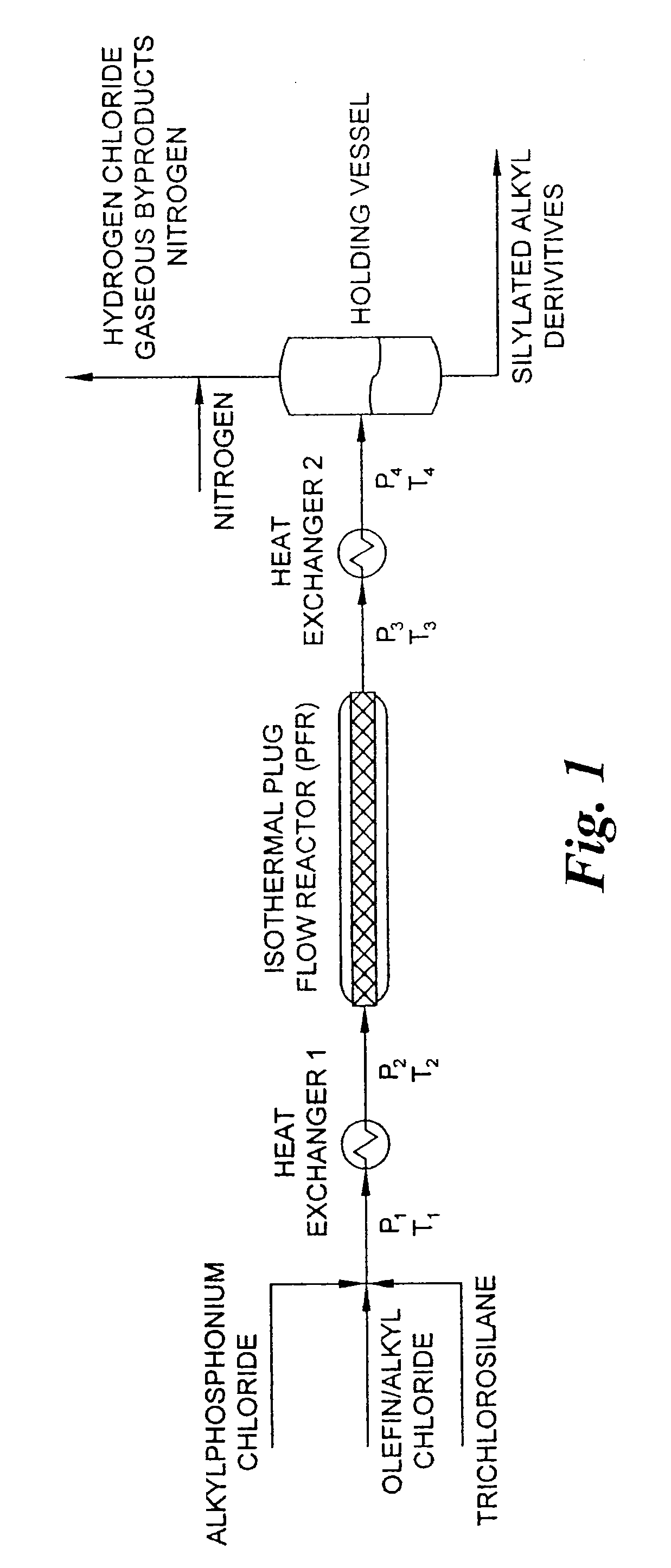Organochlorosilane and dipodal silane compounds
a technology which is applied in the field of organic silane and dipodal silane compounds, can solve the problems of large amount of waste by-products, large amount of labor and time-consuming operation, and hazardous materials such as dichlorosilane and silane, and achieves the effects of reducing or eliminating by-products, short residence time, and greater flexibility
- Summary
- Abstract
- Description
- Claims
- Application Information
AI Technical Summary
Benefits of technology
Problems solved by technology
Method used
Image
Examples
example 1
[0055] This example describes a reactor design which is a continuous PFR having three heating zones, such as described above in connection with FIG. 1. More specifically, the heating zones are: Zone 1 which pre-heats the reactants to 180° C.; Zone 2 which has a volume of 2851.7 milliliter equipped with 24 static mixing elements and maintains the reaction mixture at 180° C. for the desired residence time; and Zone 3 which reduces the reaction mixture temperature from the reaction temperature to room temperature. Trichlorosilane, benzyl chloride and a 50% solution of tetradecyltributylphosphonium chloride in toluene are fed to the PFR reactor by a dual feed pump in a 3:1:0.1 molar ratio, respectively, at a rate molar to maintain a one hour residence time in the reactor. The reaction pressure is adjusted by utilizing a back-pressure regulating valve set to 350 p.s.i. The reaction products are collected in a vessel which allows a by-product of hydrogen chloride to be vented to an acid g...
example 2
[0056] By utilizing the same reactor, ancillary equipment and procedure as in Example 1 above, trichlorosilane, 1-decene and tetradecyltributylphosphonium chloride 50% in toluene are fed in a 2:1:0.1 molar ratio, respectively, at a rate to maintain a two hour residence time. As in Example 1, the reaction mixture is maintained at a temperature of 180° C. and a pressure of 350 p.s.i. The reaction mixture is collected in a vessel which allows a by-product of hydrogen chloride to be vented to an acid gas scrubber. A gas chromatogram of the reaction mixture shows that the mixture is 5.4 weight percent decyltrichlorosilane, 70.3 weight percent 1,2-bis(trichlorosilyl)decane (a novel compound), trichlorosilyldichlorosilyldecane isomers, and a balance of tetrachlorosilane and toluene.
example 3
[0057] By utilizing the same reactor, ancillary equipment and procedure as Example 1 above, trichlorosilane allyl chloride and tetrabutylphosphonium chloride 50% in toluene are fed in a 2:1:0.05 molar ratio, respectively, at a rate to maintain a one hour resistance time. Zone 2 of the reactor maintains the temperature of the reaction mixture at 130° C., and the pressure in the reactor is adjusted by setting the back-pressure regulated valve to 150 p.s.i. to 200 p.s.i. The reaction mixture is collected in a vessel which allows the hydrogen chloride by-product to be vented to an acid gas scrubber. A gas chromatogram of the reaction mixture shows that the mixture was 48 wt% allyltrichlorosilane, 3 wt% chloropropyltrichlorosilane and 2 wt% 1,3-bis(trichlorosilyl)propane, the balance being composed of tetrachlorosilane and toluene.
PUM
| Property | Measurement | Unit |
|---|---|---|
| residence time | aaaaa | aaaaa |
| residence time | aaaaa | aaaaa |
| residence time | aaaaa | aaaaa |
Abstract
Description
Claims
Application Information
 Login to View More
Login to View More - R&D Engineer
- R&D Manager
- IP Professional
- Industry Leading Data Capabilities
- Powerful AI technology
- Patent DNA Extraction
Browse by: Latest US Patents, China's latest patents, Technical Efficacy Thesaurus, Application Domain, Technology Topic, Popular Technical Reports.
© 2024 PatSnap. All rights reserved.Legal|Privacy policy|Modern Slavery Act Transparency Statement|Sitemap|About US| Contact US: help@patsnap.com










